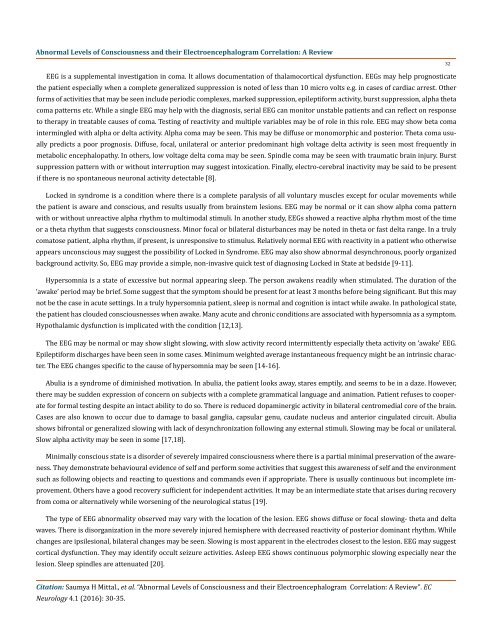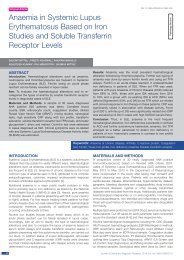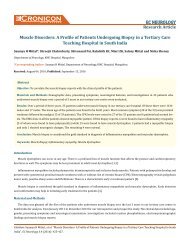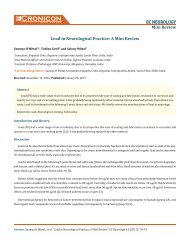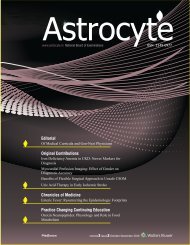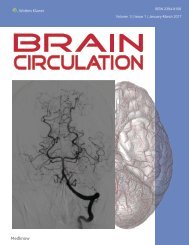Abnormal Levels of Consciousness and their Electroencephalogram Correlation- A Review
Create successful ePaper yourself
Turn your PDF publications into a flip-book with our unique Google optimized e-Paper software.
<strong>Abnormal</strong> <strong>Levels</strong> <strong>of</strong> <strong>Consciousness</strong> <strong>and</strong> <strong>their</strong> <strong>Electroencephalogram</strong> <strong>Correlation</strong>: A <strong>Review</strong><br />
EEG is a supplemental investigation in coma. It allows documentation <strong>of</strong> thalamocortical dysfunction. EEGs may help prognosticate<br />
the patient especially when a complete generalized suppression is noted <strong>of</strong> less than 10 micro volts e.g. in cases <strong>of</strong> cardiac arrest. Other<br />
forms <strong>of</strong> activities that may be seen include periodic complexes, marked suppression, epileptiform activity, burst suppression, alpha theta<br />
coma patterns etc. While a single EEG may help with the diagnosis, serial EEG can monitor unstable patients <strong>and</strong> can reflect on response<br />
to therapy in treatable causes <strong>of</strong> coma. Testing <strong>of</strong> reactivity <strong>and</strong> multiple variables may be <strong>of</strong> role in this role. EEG may show beta coma<br />
intermingled with alpha or delta activity. Alpha coma may be seen. This may be diffuse or monomorphic <strong>and</strong> posterior. Theta coma usually<br />
predicts a poor prognosis. Diffuse, focal, unilateral or anterior predominant high voltage delta activity is seen most frequently in<br />
metabolic encephalopathy. In others, low voltage delta coma may be seen. Spindle coma may be seen with traumatic brain injury. Burst<br />
suppression pattern with or without interruption may suggest intoxication. Finally, electro-cerebral inactivity may be said to be present<br />
if there is no spontaneous neuronal activity detectable [8].<br />
Locked in syndrome is a condition where there is a complete paralysis <strong>of</strong> all voluntary muscles except for ocular movements while<br />
the patient is aware <strong>and</strong> conscious, <strong>and</strong> results usually from brainstem lesions. EEG may be normal or it can show alpha coma pattern<br />
with or without unreactive alpha rhythm to multimodal stimuli. In another study, EEGs showed a reactive alpha rhythm most <strong>of</strong> the time<br />
or a theta rhythm that suggests consciousness. Minor focal or bilateral disturbances may be noted in theta or fast delta range. In a truly<br />
comatose patient, alpha rhythm, if present, is unresponsive to stimulus. Relatively normal EEG with reactivity in a patient who otherwise<br />
appears unconscious may suggest the possibility <strong>of</strong> Locked in Syndrome. EEG may also show abnormal desynchronous, poorly organized<br />
background activity. So, EEG may provide a simple, non-invasive quick test <strong>of</strong> diagnosing Locked in State at bedside [9-11].<br />
Hypersomnia is a state <strong>of</strong> excessive but normal appearing sleep. The person awakens readily when stimulated. The duration <strong>of</strong> the<br />
‘awake’ period may be brief. Some suggest that the symptom should be present for at least 3 months before being significant. But this may<br />
not be the case in acute settings. In a truly hypersomnia patient, sleep is normal <strong>and</strong> cognition is intact while awake. In pathological state,<br />
the patient has clouded consciousnesses when awake. Many acute <strong>and</strong> chronic conditions are associated with hypersomnia as a symptom.<br />
Hypothalamic dysfunction is implicated with the condition [12,13].<br />
The EEG may be normal or may show slight slowing, with slow activity record intermittently especially theta activity on ‘awake’ EEG.<br />
Epileptiform discharges have been seen in some cases. Minimum weighted average instantaneous frequency might be an intrinsic character.<br />
The EEG changes specific to the cause <strong>of</strong> hypersomnia may be seen [14-16].<br />
Abulia is a syndrome <strong>of</strong> diminished motivation. In abulia, the patient looks away, stares emptily, <strong>and</strong> seems to be in a daze. However,<br />
there may be sudden expression <strong>of</strong> concern on subjects with a complete grammatical language <strong>and</strong> animation. Patient refuses to cooperate<br />
for formal testing despite an intact ability to do so. There is reduced dopaminergic activity in bilateral centromedial core <strong>of</strong> the brain.<br />
Cases are also known to occur due to damage to basal ganglia, capsular genu, caudate nucleus <strong>and</strong> anterior cingulated circuit. Abulia<br />
shows bifrontal or generalized slowing with lack <strong>of</strong> desynchronization following any external stimuli. Slowing may be focal or unilateral.<br />
Slow alpha activity may be seen in some [17,18].<br />
Minimally conscious state is a disorder <strong>of</strong> severely impaired consciousness where there is a partial minimal preservation <strong>of</strong> the awareness.<br />
They demonstrate behavioural evidence <strong>of</strong> self <strong>and</strong> perform some activities that suggest this awareness <strong>of</strong> self <strong>and</strong> the environment<br />
such as following objects <strong>and</strong> reacting to questions <strong>and</strong> comm<strong>and</strong>s even if appropriate. There is usually continuous but incomplete improvement.<br />
Others have a good recovery sufficient for independent activities. It may be an intermediate state that arises during recovery<br />
from coma or alternatively while worsening <strong>of</strong> the neurological status [19].<br />
The type <strong>of</strong> EEG abnormality observed may vary with the location <strong>of</strong> the lesion. EEG shows diffuse or focal slowing- theta <strong>and</strong> delta<br />
waves. There is disorganization in the more severely injured hemisphere with decreased reactivity <strong>of</strong> posterior dominant rhythm. While<br />
changes are ipsilesional, bilateral changes may be seen. Slowing is most apparent in the electrodes closest to the lesion. EEG may suggest<br />
cortical dysfunction. They may identify occult seizure activities. Asleep EEG shows continuous polymorphic slowing especially near the<br />
lesion. Sleep spindles are attenuated [20].<br />
32<br />
Citation: Saumya H Mittal., et al. “<strong>Abnormal</strong> <strong>Levels</strong> <strong>of</strong> <strong>Consciousness</strong> <strong>and</strong> <strong>their</strong> <strong>Electroencephalogram</strong> <strong>Correlation</strong>: A <strong>Review</strong>”. EC<br />
Neurology 4.1 (2016): 30-35.


